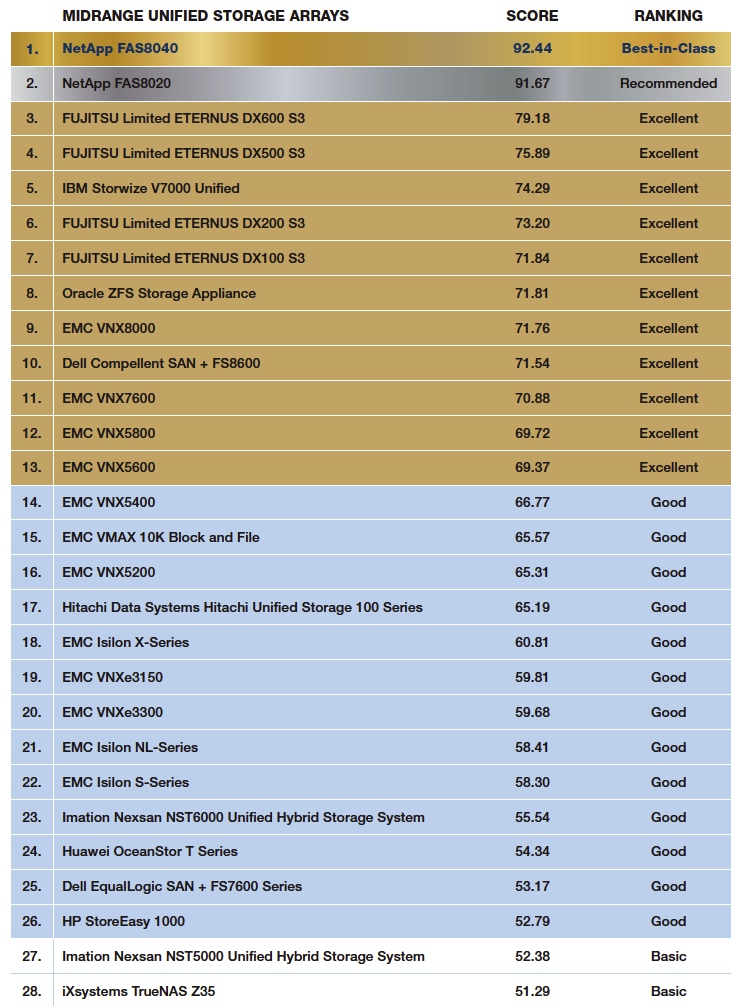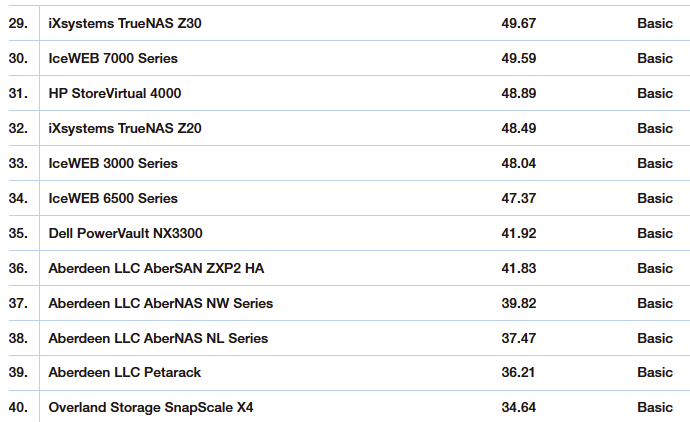NetApp, Fujitsu and IBM With Best Mid-Range Unified Storage Arrays
Reports DCIG in buyer's guide
This is a Press Release edited by StorageNewsletter.com on September 3, 2014 at 3:00 pmAlmost as certain as the continued explosion of data where reports that 90% of data created in the world today has been created in the last two years alone, IT administrators are faced with an explosion of storage options to meet their growing storage requirements. This is clear in the growing unified storage category, where the choice of NAS or SAN can now be handled in a single solution, managing both file and block storage data.
As the demand for storage continues to grow, users are turning more to midrange unified storage arrays that combine capacity, versatility and manageability in a single package.
There have been significant changes since last year’s Buyer’s Guide for Midrange Unified Storage Arrays from DCIG LLC. While the majority of arrays topped out at 720GB in last year’s guide, the vast majority of drives in this year’s guide support at least 1.8PB and many can scale upwards to 4PB. Additionally, the majority of midrange unified arrays in last year’s guide supported a total cache of 96GB or less, and only a quarter of arrays supported caches greater than 1TB. This year, the majority of arrays supported total cache of 600GB and 3TB respectively. Both advancements point to an increased benefit for users on performance and greater storage capacity for less money, with the added benefit of a smaller storage footprint in the data center.
“We know organizations are looking to strike a balance between pure hardware horsepower and greater management capabilities,” said Ken Clipperton, DCIG analyst and co-author of the DCIG 2014-15 Midrange Unified Storage Array Buyer’s Guide. “Since midrange unified storage solutions serve as a ‘jack of all trades’ that combine both power and manageability in a single package, we placed more emphasis on solutions that combine the ability to handle the explosion of data with ease of management. For that reason, data efficiency technologies that enable a midrange unified array to store more data in less space and features that enable an array to be managed from within familiar management interfaces, including virtual server, became a premium. We also recognized the importance of monitoring and proactively resolving issues as they occur, quickly and efficiently.”
For the DCIG 2014-15 Midrange Unified Storage Array Buyer’s Guide, DCIG evaluated 40 offerings from 14 companies. After an initial survey containing more than 130 questions was completed, product capabilities were assessed based on a combination of data provided by the vendor, prior DCIG research, the analyst’s own knowledge of the product and publicly available information. Products were then evaluated on more than 200 features. After scores were compiled, products were ranked Best-in-Class, Recommended, Excellent, Good, or Basic across functionality and capability relative to the other products included in the Buyer’s Guide.
The intent for this guide, as with all DCIG guides, is to provide an ‘at-a-glance’ comparison from which end users can select the most appropriate solution for their needs. It also provides perspective on how solutions from less well known midrange unified storage arrays compare against established and better known brands.
The DCIG 2014-15 Midrange Unified Storage Array Buyer’s Guide Top 10 solutions include (in alphabetical order): Dell Compellent SAN + FS8600; EMC VNX8000; Fujitsu Limited ETERNUS DX100 S3, DX200 S3, DX500 S3, DX600 S3; IBM Storwize V7000 Unified; NetApp FAS8020, FAS8040; Oracle ZFS Storage Appliance.
NetApp FAS8040 and NetApp FAS8020 achieved Excellent or Recommended across all scoring categories. In particular, these two arrays were distinguished through comprehensive management and software features. Data services provided by NetApp’s mature and full-featured Data ONTAP storage OS helped both arrays stand out.
Both arrays achieved high marks against competitive solutions in following ways:
- Support for NAS virtualization and virtual domains: Both arrays have the ability to appear as multiple NAS devices and to be managed as multiple virtual private arrays.
- Support for both compression and deduplication: By implementing both technologies, the arrays achieve higher overall data efficiency and the ability to store more data in the least space.
- Use of flash memory for both read and write caching: These models provide low-latency flash caches up to 6TB and 12TB respectively.
- Proactive remediation: These models were among the few that offered both remote monitoring and proactive remediation. Proactive remediation minimizes the number and duration of service interruptions by reducing troubleshooting time and expertise required of IT staff.
The DCIG 2014-15 Midrange Unified Storage Array Buyer’s Guide achieves the following objectives:
- Provides an objective, third party evaluation of each midrange unified storage array that evaluates and scores their features from an end user’s perspective
- Scores and ranks features of each midrange unified storage array based on criteria that matter most to end users
- Provides a standardized data sheet for each midrange unified storage array so users may do quick side-by-side comparisons of products
- Provides insight into the management, data efficiency, VMware integration, hardware and technical support features which organizations may look for in a unified storage solution
- Gives any organization a solid foundation for getting competitive bids from different providers that are based on apples-to-apples comparisons
Clipperton added: “We fully anticipate midrange unified arrays to fill a wide range of needs within IT infrastructures. They provide the right balance of strong feature set and powerful hardware. With that said: we expect the category to evolve, so look for advances in deduplication, flash-based caching and public cloud integration, especially as organizations continue to look for cost-effective ways to handle the ever increasing volume of data. As with all our guides, we know this guide will be an important resource for users looking for the right midrange unified storage array to handle their specific needs.“
DCIG identified 14 companies that provide midrange unified storage arrays.
Each midrange unified storage array had to meet the following criteria:
- Be available as an appliance, on a single SKU, and includes its own hardware and software
- Support the presentation of storage as a single file system in a global namespace
- Support Ethernet connectivity
- Support both the CIFS/SMB and NFS NAS protocols
- Support one or more SAN protocols (iSCSI, FC, FCoE)
- Primarily function using storage local to the device and/or its direct peers (more than a cloud gateway)
- Support scaling to at least two controllers
- Support scaling to a minimum of 60TB of raw capacity
- Ship prior to June 15, 2014
- Sufficient information for DCIG to make meaningful decisions
No vendors, whether clients or not, were afforded preferential treatment in guide. All research was based upon information provided directly by vendors, research and analysis by DCIG and other publicly available information.
It is worth noting that each buyer’s guide is not intended to be a substitute for internal testing. The information on each data sheet about each product’s functionality represents the opinion of DCIG. DCIG encourages any organization that is considering the purchase of any solution included in a Buyer’s Guide to do its own in-house testing and to validate the functionality of each feature.
To donwload the DCIG 2014-15 Midrange Unified Storage Array Buyer’s Guide (registration needed)














 Subscribe to our free daily newsletter
Subscribe to our free daily newsletter
